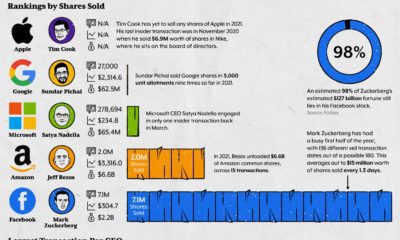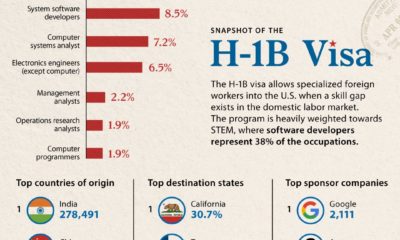Investors and wealth managers are always looking to capitalize on their investments—and the latest innovations are arming them with more efficient tools to get there. Fintech solutions are increasingly being adopted among the digitally active population, as 64% of surveyed wealth managers consider digitization essential in 2019. Today’s graphic from Raconteur highlights the benefits of investment technology, and touches on shifting sentiments in human vs. digital interactions. Where do investors and wealth managers see the next epoch of investment fintech heading?
Fantastic Features: Top Benefits
According to a TD Ameritrade survey of 1,000 investors, a whopping 90% consider getting tailored investing advice to be the most important feature of any tech tool. In second place, 52% place value in easy access to their data. Here are the other benefits at top of mind for investors when it comes to investment tech:
45% seek the best possible returns 44% look for customized, quick, and simple analysis 39% are interested in customized portfolios 39% want the benefit of personalized budgets 38% desire regular suggestions for optimizing financial health
But how well are these applications being adopted in everyday investment scenarios?
The Fintech Boom by the Numbers
Investment apps such as RobinHood have drastically risen in popularity, but still lag behind more mainstream segments in the fintech space: Fintech Categories Ranked by Adoption Rate, 2015 to 2019 Source: EY Borrowing apps have the lowest global usage rates—only 27% of the digitally active global population—whereas nearly 75% have adopted money transfer and payment apps.
Human vs Machine: The Customer Experience
Do humans or machines have the edge in managing your investments? The aforementioned survey by TD Ameritrade also asked investors which of the following are performed better by each group, with mixed results: When it comes to managing tasks such as calculations, updates, and portfolio optimization, the majority of investors consider a computer to be better suited to the tasks at hand. However, when they are discussing investment concerns, personalization, or financial advice, the majority of customers prefer a human opinion. Interestingly, 81% of U.S. investors believe that investment technology could never replace the “human touch”, compared to 70% of European investors or 64% in Asia.
Wealth Managers are Going Digital
Over time, wealth managers have grown to embrace the digitization of their industry. The proportion of surveyed high-level executives who see digitization as essential to the industry jumped from just 25% in 2016 to 64% in 2019. In another recent survey about views on most impactful types of fintech apps, more than 68% of wealth managers agreed that robo-advisors are among the most important developments, with AI-based investing apps following closely behind at 45%.
Towards a More Personalized Future
At the end of the day, investors want better, more personalized advice at their disposal—and for that advice to generate more profitable returns. Along with their wealth managers, investors are increasingly interested in solutions that can simplify portfolio management. Digitization and automation of manual processes have been a welcome change for many industry professionals. While investment technology is still in early stages, wealth managers can personalize investor experiences through the adoption of tech─and increase their chances of future success by maintaining a seamless customer experience. on But fast forward to the end of last week, and SVB was shuttered by regulators after a panic-induced bank run. So, how exactly did this happen? We dig in below.
Road to a Bank Run
SVB and its customers generally thrived during the low interest rate era, but as rates rose, SVB found itself more exposed to risk than a typical bank. Even so, at the end of 2022, the bank’s balance sheet showed no cause for alarm.
As well, the bank was viewed positively in a number of places. Most Wall Street analyst ratings were overwhelmingly positive on the bank’s stock, and Forbes had just added the bank to its Financial All-Stars list. Outward signs of trouble emerged on Wednesday, March 8th, when SVB surprised investors with news that the bank needed to raise more than $2 billion to shore up its balance sheet. The reaction from prominent venture capitalists was not positive, with Coatue Management, Union Square Ventures, and Peter Thiel’s Founders Fund moving to limit exposure to the 40-year-old bank. The influence of these firms is believed to have added fuel to the fire, and a bank run ensued. Also influencing decision making was the fact that SVB had the highest percentage of uninsured domestic deposits of all big banks. These totaled nearly $152 billion, or about 97% of all deposits. By the end of the day, customers had tried to withdraw $42 billion in deposits.
What Triggered the SVB Collapse?
While the collapse of SVB took place over the course of 44 hours, its roots trace back to the early pandemic years. In 2021, U.S. venture capital-backed companies raised a record $330 billion—double the amount seen in 2020. At the time, interest rates were at rock-bottom levels to help buoy the economy. Matt Levine sums up the situation well: “When interest rates are low everywhere, a dollar in 20 years is about as good as a dollar today, so a startup whose business model is “we will lose money for a decade building artificial intelligence, and then rake in lots of money in the far future” sounds pretty good. When interest rates are higher, a dollar today is better than a dollar tomorrow, so investors want cash flows. When interest rates were low for a long time, and suddenly become high, all the money that was rushing to your customers is suddenly cut off.” Source: Pitchbook Why is this important? During this time, SVB received billions of dollars from these venture-backed clients. In one year alone, their deposits increased 100%. They took these funds and invested them in longer-term bonds. As a result, this created a dangerous trap as the company expected rates would remain low. During this time, SVB invested in bonds at the top of the market. As interest rates rose higher and bond prices declined, SVB started taking major losses on their long-term bond holdings.
Losses Fueling a Liquidity Crunch
When SVB reported its fourth quarter results in early 2023, Moody’s Investor Service, a credit rating agency took notice. In early March, it said that SVB was at high risk for a downgrade due to its significant unrealized losses. In response, SVB looked to sell $2 billion of its investments at a loss to help boost liquidity for its struggling balance sheet. Soon, more hedge funds and venture investors realized SVB could be on thin ice. Depositors withdrew funds in droves, spurring a liquidity squeeze and prompting California regulators and the FDIC to step in and shut down the bank.
What Happens Now?
While much of SVB’s activity was focused on the tech sector, the bank’s shocking collapse has rattled a financial sector that is already on edge.
The four biggest U.S. banks lost a combined $52 billion the day before the SVB collapse. On Friday, other banking stocks saw double-digit drops, including Signature Bank (-23%), First Republic (-15%), and Silvergate Capital (-11%).
Source: Morningstar Direct. *Represents March 9 data, trading halted on March 10.
When the dust settles, it’s hard to predict the ripple effects that will emerge from this dramatic event. For investors, the Secretary of the Treasury Janet Yellen announced confidence in the banking system remaining resilient, noting that regulators have the proper tools in response to the issue.
But others have seen trouble brewing as far back as 2020 (or earlier) when commercial banking assets were skyrocketing and banks were buying bonds when rates were low.











